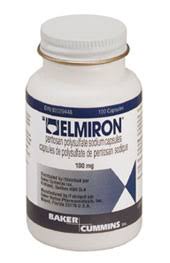 DRUG CLASS AND MECHANISM: Pentosan is a semi-synthetic (man-made) drug that resembles the anticoagulant ("blood thinner") heparin and is used for treating the symptoms of interstitial cystitis. Interstitial cystitis is a condition, usually of unknown cause, in which there is inflammation of the urinary bladder that most frequently causes pelvic pain and frequent urination. The exact mechanism whereby pentosan reduces the symptoms of interstitial cystitis also is unknown; however, scientists believe that pentosan may coat the lining of the bladder and prevent irritating substances in the urine from reaching the cells of the lining. The FDA approved pentosan in September 1996.
DRUG CLASS AND MECHANISM: Pentosan is a semi-synthetic (man-made) drug that resembles the anticoagulant ("blood thinner") heparin and is used for treating the symptoms of interstitial cystitis. Interstitial cystitis is a condition, usually of unknown cause, in which there is inflammation of the urinary bladder that most frequently causes pelvic pain and frequent urination. The exact mechanism whereby pentosan reduces the symptoms of interstitial cystitis also is unknown; however, scientists believe that pentosan may coat the lining of the bladder and prevent irritating substances in the urine from reaching the cells of the lining. The FDA approved pentosan in September 1996.
PRESCRIPTION: Yes
GENERIC AVAILABLE: No
PREPARATIONS: Capsules: 100 mg.
STORAGE: Pentosan should be stored at room temperature, between 15 C to 30 C (59 F to 86 F).
PRESCRIBED FOR: Pentosan is used for relieving bladder pain caused by interstitial cystitis.
DOSING: The recommended dose of pentosan is 100 mg three times daily (every 8 hours) taken at least one hour before or two hours after meals so that food does not retard its absorption. Patients should be evaluated after 3 months, and treatment may be continued for another three months if patients have not improved and they are tolerating pentosan.
DRUG INTERACTIONS: Pentosan resembles heparin and it affects the ability of blood to clot. Therefore, it can cause bleeding and if combined with other drugs that also cause bleeding (anticoagulants) the risk of bleeding may increase. Examples of drugs that cause bleeding include heparin, streptokinase, aspirin, nonsteroidal anti-inflammatory drugs (for example,ibuprofen), and warfarin (Coumadin).
PREGNANCY: Studies with pentosan have not been conducted in pregnant women.
NURSING MOTHERS: Studies of pentosan have not been conducted innursing mothers.
SIDE EFFECTS: The most common side effects of pentosan are stomach upset, diarrhea, nausea, headache, rash, abdominal pain, hair loss anddizziness. Some patients may develop abnormalities of liver tests in the blood. Bleeding from the rectum and other areas also may occur.
USES: This medication is used to treat pain/discomfort from a certain bladder disorder (interstitial cystitis). It may work by forming a layer on the bladder wall and protecting it from harmful/irritating substances in the urine. It is also a weak "blood thinner" and therefore may increase the risk of bruising/bleeding (e.g., bleeding from the nose/gums).
HOW TO USE: Read the Medication Guide provided by your pharmacist before you start using this drug and each time you get a refill. If you have any questions, consult your doctor or pharmacist.Take this medication by mouth at least 1 hour before or 2 hours after meals, usually 3 times daily or as directed by your doctor.Use this medication regularly to get the most benefit from it. To help you remember, take it at the same times each day.Do not increase your dose or take this medication more often than prescribed. Your condition will not improve any faster, and the risk of serious side effects may be increased.Inform your doctor if your condition worsens or does not improve after 3 months.



.jpg)
.jpg)
